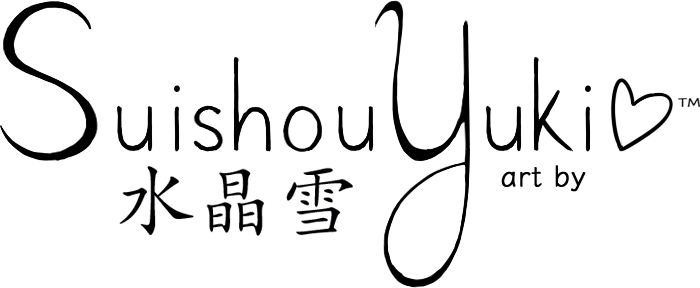(Pictures to be added soon.)
Hi, everyone~~ ^v^/ Today I’d like to talk about line art (inking).
Line art is an image consisting only of lines–no sketch marks are visible, and the image is not colored, though the line art itself can be colored. “Linearting” is a process in which an artist inks over a sketch; it is also commonly referred to as “inking”, even digitally, where no actual ink is involved. Often it is the second part of a three-part process: sketch -> ink -> color.
Since you can achieve different looks with different lines, they help to express different moods and create a wide variety of unique art styles when combined with that individual touch. ^^
Line Art Styles and Techniques
Colored Lines
I mentioned just a moment ago that line art can be colored. This can be done to lines without coloring the rest of the image, or as a type of coloring style in which the artist fills in all the color in the image and then goes back over the black lines in whole or in part with colors similar to what they are surrounding, in order to make them softer.
In SAI, you can color over lines by changing the layer mode to Selection Source, creating a new layer and Clip it, and then going over the line art with the color you choose. ^^
To color your lines traditionally, you can use different colors of pens (for example, Copic Multiliners) to achieve a similar effect. Plan out your drawing in advance so you know for sure which parts will get which color.
Thin Lines
Using thin lines in your artwork can help give it a soft or delicate feel. Thin lines on a background can help it recede and give more focus to the foreground, which could be inked with slightly thicker lines. With different types of coloring, thin lines can mean more realistic-looking artwork. Thin lines are more often associated with shoujo manga (comics for girls), but lately I’ve seen both shoujo and shounen manga (comics aimed at boys) have more of a medium line weight. Maybe that’s just me, though. XD I think this also depends on the medium used.
Achieve thin lines by 1) pressing down lightly; 2) selecting a super-fine-point pen; or 3) selecting a small brush size on your digital art program of choice (ex. smaller than 2 px).
Thick Lines
Thicker line weights give a bold appearance to artwork.
Achieve thick lines by 1) pressing down harder (not too hard!); 2) selecting a normal- to larger-than-normal-sized pen; or 3) selecting a larger brush size on your digital art program of choice (ex. larger than 4 px).
Flat Lines vs. Lines with Depth
No, “flat lines” this doesn’t mean lines that aren’t 3D. Lol. Flat lines are lines drawn without much change in line weight and no depth (I call it “extra shadows” if that makes sense??). While flat lines are fine, adding in those “extra shadows” can help to add a little extra visual interest to your art. It seems like such a small thing–that’s what I thought at first too–but it really does make a difference! All you have to do is add a little bit of extra ink to small parts of your line art where shadows will fall.
You can also do this around parts that have a roundness to them, such as the curve of a cheek, hip, or nose. Even adding a teeny tiny shadow to an eyelid enhances it a lot.
How to Make Good Line Art
Tips to reduce shakiness and make smooth lines
When inking, unless you’re going for a specific look, don’t “sketch” with your pen. Even if you digitally go back and clean up the lines, it won’t look as clean as it will if you let your lines flow. Be patient with it. ^^ You can rotate the paper or the canvas if you can’t quite get the right angle to make a smooth stroke.
In SAI, you can adjust the stabilizer to help, well, stabilize your pen strokes. The higher the number, the slower your stroke will be, but the line will be all the smoother. (I usually keep mine set at 7; the default is 3.) If you “ink” with the pen tool, it will also automatically remove small “bumps” in the stroke.
If you have unsteady hands…try to brace your arm, wrist, or hand (depends) against something and/or make shorter, quicker strokes. That may help. ^^
Don’t be messy
It may be obvious, but line art should generally be clean and neat. Make sure your pens are working properly and watch out for smudging. ><
Vary your line width
…Not sure how to explain this. It needs a picture! ><
~
So, which do you like better...sketching or inking? What do you think is the hardest part about inking? What do you think is the easiest part? Got any tips you'd like to share? (I'd really like to know!) Leave them below! ^^/
This post is a part of my August Art series. I’ll do a Q&A post at the end of the month, so if you have an art-related question or just want to ask me something, ask away! *(*´∀`*)☆
